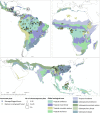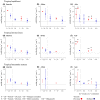Estimating aboveground net biomass change for tropical and subtropical forests: Refinement of IPCC default rates using forest plot data
- PMID: 31310673
- PMCID: PMC6852081
- DOI: 10.1111/gcb.14767
Estimating aboveground net biomass change for tropical and subtropical forests: Refinement of IPCC default rates using forest plot data
Abstract
As countries advance in greenhouse gas (GHG) accounting for climate change mitigation, consistent estimates of aboveground net biomass change (∆AGB) are needed. Countries with limited forest monitoring capabilities in the tropics and subtropics rely on IPCC 2006 default ∆AGB rates, which are values per ecological zone, per continent. Similarly, research into forest biomass change at a large scale also makes use of these rates. IPCC 2006 default rates come from a handful of studies, provide no uncertainty indications and do not distinguish between older secondary forests and old-growth forests. As part of the 2019 Refinement to the 2006 IPCC Guidelines for National Greenhouse Gas Inventories, we incorporate ∆AGB data available from 2006 onwards, comprising 176 chronosequences in secondary forests and 536 permanent plots in old-growth and managed/logged forests located in 42 countries in Africa, North and South America and Asia. We generated ∆AGB rate estimates for younger secondary forests (≤20 years), older secondary forests (>20 years and up to 100 years) and old-growth forests, and accounted for uncertainties in our estimates. In tropical rainforests, for which data availability was the highest, our ∆AGB rate estimates ranged from 3.4 (Asia) to 7.6 (Africa) Mg ha-1 year-1 in younger secondary forests, from 2.3 (North and South America) to 3.5 (Africa) Mg ha-1 year-1 in older secondary forests, and 0.7 (Asia) to 1.3 (Africa) Mg ha-1 year-1 in old-growth forests. We provide a rigorous and traceable refinement of the IPCC 2006 default rates in tropical and subtropical ecological zones, and identify which areas require more research on ∆AGB. In this respect, this study should be considered as an important step towards quantifying the role of tropical and subtropical forests as carbon sinks with higher accuracy; our new rates can be used for large-scale GHG accounting by governmental bodies, nongovernmental organizations and in scientific research.
Keywords: (sub)tropical forests; IPCC; biomass change; global ecological zones; managed and logged forests; old-growth forests; secondary forests.
© 2019 The Authors. Global Change Biology Published by John Wiley & Sons Ltd.
Figures







References
-
- Alves, D. , Soares, J. V. , Amarral, S. , Mello, E. , Almeida, S. , Da Silva, O. F. , & Silveira, A. (1997). Biomass of primary and secondary vegetation in Rondonia, Western Brazilian Amazon. Global Change Biology, 3(5), 451–461. 10.1046/j.1365-2486.1997.00081.x - DOI
-
- Anderson‐Teixeira, K. J. , Hermman, V. , Wang, M. M. H. , Bond‐Lamberty, B. , LeBauer, D. , & Sanchez Padial, A. J. (2018). forc‐db/ForC: Version for IPCC 2019 updated default tables for biomass growth of natural forests in the (sub)tropics. 10.5281/ZENODO.1230565 - DOI
Publication types
MeSH terms
Substances
LinkOut - more resources
Full Text Sources
Research Materials

